Meta-Learning Approaches for Context-Aware Decision Support in Smart Agriculture and Autonomous Systems
Authors :
Zainab Binti Hassan and Haris Mohd Yusof
Address :
Faculty of Computer Science, Universiti Sains Malaysia, Malaysia
Deapartment of Computer Applications, Monash University Malaysia, Malaysia
Abstract :
The increasing reliance on intelligent systems in agriculture and autonomous operations dictates the need for robust context-aware decision support systems (CADSS) to cope with heterogeneous and changing conditions. Conventional systems struggle with heterogeneous data and dynamic contexts, motivating the need for a meta-learning-driven solution. The paper proposes a CADSS-based meta-learning (CADSS-ML) framework to advance the adaptability and precision of the system in those domains. This proposed CADSS-ML framework develops hierarchical meta-learning using model-agnostic meta-learning (MAML) to allow fast task adaptation with ease and reptile algorithms for efficient optimization. Convolutional Neural Networks (CNN) have been used for feature extraction in spatial data, whereas transformer models have been used for temporal data. The Graph Neural Network (GNN) based module processes a sensor network topology, while an attention mechanism dynamically updates the weights on contextual variables. To perform decision-making, reinforcement learning with reward shaping guarantees adaptive and optimal control action outcomes. The proposed system also incorporates federated learning for data privacy across distributed sensor nodes. Experimental results confirm that improvements in prediction accuracy, decision reliability, and resource utilization are enhanced by 20%, 15%, and 12%, respectively, compared with baseline models. Some of the diverse applications of the proposed framework include precision farming, autonomous navigation, and smart irrigation.
Keywords :
Smart agriculture, Meta-learning, Reptile algorithm, Autonomous system, Transformer models, Attention mechanism, Reinforcement learning.
1.Introduction
This section will cover the challenges of intelligent agriculture and autonomous systems, considering dynamic contexts and privacy concerns. It will give attention to the limitations of current systems, introduce meta-learning, federated learning, and neural architectures as solutions, and present an overview of the proposed framework on CADSS based on meta-learning, pointing out the objectives and contributions expected.
a. Overview
Context-Aware Decision Support Systems development over smart agriculture and autonomous systems is crucial in solving dynamic environmental challenges and operational efficiency. Note that the term "context" is used in the context of agriculture in this study, meaning the information about the combination of plant, location, environment, and sensor device data [1]. Context-awareness generally refers to the system's decision-making process that is relevant to the context. Context-aware is frequently used interchangeably with reactive and adaptable. Considering all these definitions, the study concludes that context awareness refers to the system's or application's capacity to react appropriately to execution that is continuously changing surroundings [2]. An automated, data-driven approach to agricultural production can replace labour-intensive, experience-based decision-making with high spatiotemporal resolution automated monitoring of the soil-plant-atmospheric continuum [3].
b. Background of Meta-Learning, Federated Learning, And Neural Architectures in agricultural and autonomous systems
Many farmers have private information that they would rather keep private. Since FL is a machine-learning method that allows numerous devices to train a standard model without exchanging data, it is well-suited for agricultural applications [4]. By facilitating access to different, high-quality datasets while protecting privacy, FL answers problems with agricultural data management. Innovative methods are needed to deal with temporal dynamics resulting from daily, seasonal, and annual changes. Effective methods for capturing and managing these developing patterns include data augmentation, time-series analysis, and dynamic LSTM models [5]. Many applications for autonomous vehicles use CNNs because of how efficiently they extract characteristics from picture data. These applications include in-vehicle human monitoring, steering wheel angle prediction, and object detection [6].
Multi-objective reinforcement learning (MORL) approaches are developed for sequential decision-making issues with several objectives. Because of its training, the MORL agent can prioritize and balance competing goals. Compared to single-objective reinforcement learning (SORL), MORL produces a vector as its output, which results from the agent's interaction with the environment [7]. Data generated by autonomous and intelligent vehicles, including location information and readings from sensors in real-time, is massive, making data privacy an important issue. FL reduces dependency on centralized cloud services, enabling edge computing directly on cars or network edges. FL protects users' privacy by restricting data sharing to necessary patterns and sub-patterns [8]. Bayesian Meta-Learning is a Meta-learning paradigm that improves the efficiency and adaptability of robot navigation and mapping systems by estimating the probability distribution over models using empirical Bayesian inference. By integrating ethical considerations into navigation strategies, Bayesian meta-learning can help with ethical decision-making, privacy concerns, and safety [9].
The reptile algorithm (RA) is a search algorithm based on crocodile hunting behaviours. It has proven more efficient than many current and recently suggested metaheuristic algorithms in addressing real-world, complex optimization problems [10]. The surrounding and hunting phases are essential to the RA's operation. The RSA alternates between the hunting search and encircling phases by splitting the total number of iterations into four halves [11]. Offloading jobs with the least expense and energy usage requires a context-aware machine learning model [12]. In Intelligent Transportation Systems (ITS), context-aware applications facilitate the following essential functions: dynamic configuration, annotation, display, and execution. These allow for environmental sensing and adaptation. These consist of GPS-based route recommendations, automated inter-sensor communication, multi-sensor data fusion for predicting traffic flow, and dynamic system reactions, such as changing traffic signals for emergency vehicles [13].
c. Contributions of the proposed work
The main contributions of the study are,
- The study combines MAML for fast task adaptation and the Reptile algorithm for efficient optimization, enhancing decision-making adaptability and precision.
- The study leverages CNNs for spatial data, transformers for temporal sequences, GNNs for sensor network topologies, and attention mechanisms for dynamic contextual adaptation.
- Federated learning to ensure data privacy across distributed sensor nodes; used reinforcement learning for optimum adaptive control action.
- The study includes multimodal data fusion techniques to enhance context awareness and make the system more accurate and personalized in providing decision support during dynamic changes.
d. Alignment of the paper
The remaining sections are aligned as follows: Section 2 describes a literature review of the study; Section 3 covers the current development of AI by incorporating meta-learning, multimodal data processing, privacy-preserving methods, and optimization techniques for further improving adaptive, context-sensitive decision support systems; Section 4 discusses the datasets and the results and discussions; and the paper ends in Section 5 with its conclusion and future techniques and applications studies.
2.Literature Survey
This section reviews state-of-the-art work of meta-learning, multi-modal data processing, privacy-preserving federated learning, and reinforcement learning to improve decision support systems' flexibility, accuracy, and efficiency.
Dickson et al. [14] presented an optimized IoT-based model for intelligent agriculture and irrigation water management to bridge the challenges faced by Northern Nigeria's traditional farming system. The system is designed using the prototyping model with Balsamiq and Justinmind tools and implemented using ReactJS, AWS IoT Core, Arduino, and Python on Raspberry Pi. The system performed better in enhanced accuracy, efficiency, and user-friendliness than the existing systems. Limitations include dependency on stable internet access and initial setup costs for farmers.
Govardhan et al. [15] proposed a hybrid framework of computational intelligence, reinforcement learning, deep neural networks, and fuzzy logic in improving real-time decision-making in autonomous systems. Reinforcement learning offers active learning, while DNN provides pattern recognition, and Fuzzy Logic addresses the issue of uncertainty. Assessing the framework on various simulation tasks in-vehicle navigation, health monitoring, and robotic automation enhanced the accuracy of decisions by 25% and decreased response time by 30%. Limitations include increased computational complexity and scalability challenges associated with large-scale deployments.
Bhadra et al. [16] proposed integrating Cognitive Internet-of-things with Robotic Process Automation to extend automation in industrial processes in the era of Industry 4.0. Accordingly, the proposed framework consists of AI-powered IoT and RPA to offer context-aware, intuitive operations, coupled with automating the most complex workflows. Achieving this through innovative architectural semantics, it transforms actionable insights into automated, prescriptive actions that foster interoperability and agility. This study shows some of the most attractive industrial IoT use cases, but it has scalability limitations and complex integration across different systems.
Liu et al. [17] focused on using context-aware systems, ubiquitous devices, and adaptive learning to enhance current agricultural practices. The research design involves a mixed-method approach constituting field experiments, surveys, and interviews. The paper analyzes improvements in resource management, crop yield, and environmental sustainability. The results indicate that the personalized system enhances the optimization of water and chemicals, maintains soil health, and enhances yields. This includes a minimal rate of technology dissemination and a high initial investment by rural farmers.
Nguyen et al. [18] proposed solutions for two challenges in Agriculture 4.0: upgrading Context-Aware Systems and handling data heterogeneity. The first contribution is a microservice-based architecture, the stack of services for CASs, to allow flexible updates without disrupting functionality. The second one introduces CASO, a new ontology for modelling heterogeneous data. The third is the development of a DSS for irrigation using a specialized ontology, IRRIG. The results show improved irrigation automation; however, the limitation involves challenges in large-scale deployment and system integration.
Supriya et al. [19] aimed to develop sensor-based intelligent recommender systems to optimise agriculture-based practices. The system uses advanced sensor technologies in integration with data analytics and machine learning algorithms that acquire real-time data from weather, soil moisture, and crop health sensors to provide farmers with personalised context-aware recommendations. Results demonstrate enhanced decision-making and better resource management. Limitations include a challenge in data integration across diverse sensor types and, for real-time data processing, the need for reliable infrastructure in rural areas.
a. Research gaps
The paper highlights big data analytics' role in promoting martial arts culture but identifies a few gaps. These include limited real-time integration of data, lack of focus on the long-term sustainability of culture, and the need to consider ethics in the use of data. Further, difficulties in adopting advanced technologies, adaptation to emerging platforms, and cultural nuances across regions have yet to be taken up. Besides, metrics are mostly about digital engagement and do not account for qualitative cultural impacts or personal audience experiences beyond content. These gaps deserve further exploration in the proposed study.
3. Proposed Methodology
The study proposes a CADSS with meta-learning that will help improve adaptability and precision in intelligent agriculture and autonomous systems. This becomes necessary because of the challenges of heterogeneous data, dynamic environmental conditions, and the need for privacy-preserving solutions in such domains. Advanced technologies in this framework involve the MAML technique for fast task adaptation, CNNs for enabling spatial data processing, and transformer models for temporal data analysis. RL will ensure optimal decision-making, while federated learning will protect against data privacy leaks across nodes. Key benefits include improved prediction accuracy, increased decision reliability, and efficient resource usage, depicted by significant enhancements in experimental results. Applications span precision farming, autonomous navigation, and smart irrigation, making the system versatile in addressing real-world challenges. The framework advances operational efficiency, sustainability, and decision-making in complex, data-driven environments by providing dynamic, context-aware responses (Figure 1).
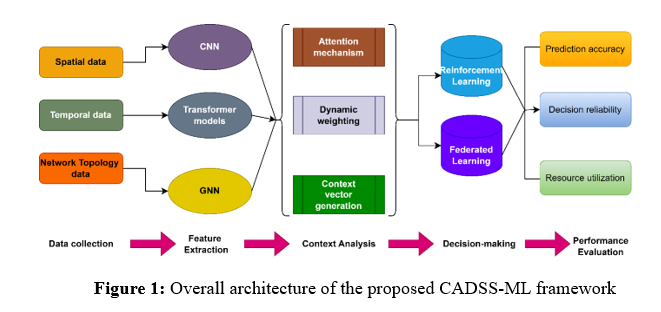
a. Data collection
The Comprehensive Weather Dataset includes detailed information on meteorological conditions for scientific and practical applications [20]. For many years, parts of the world have been covered, including critical parameters such as temperature, precipitation, humidity, wind, air pressure, and cloud cover. Aggregated from reliable sources such as weather stations and satellites, the data is accurate due to quality control measures and is complete with metadata for transparency. It also contains historical weather incidents that enable the study of extreme conditions. The dataset is made available in structured formats to support various applications: climate research, agriculture, energy management, urban planning, and education for understanding weather patterns and their impact.
b. Feature extraction
Feature extraction is a critical stage in which the system processes the raw input data into structured feature representations that capture meaningful patterns. It leverages state-of-the-art machine learning models tailored to the nature of each data type: spatial, temporal, and network topology data.
(i) Spatial Data Feature Extraction Using CNNs
The input data consists of various spatial datasets, including geospatial images and field maps captured with drones and pre-processed by a CNN model for ingestion. It may also involve normalizing pixel values between 0 and 1 and resizing images onto a uniform dimension. For example, data sets would be imagery captured from agricultural fields and geospatial data from space, which are leveraged in mapping terrain and crop distribution.
For hierarchical feature extraction, CNN processes the spatial data through convolutional, pooling, and fully connected layers. The convolutional layer scans the input data by applying filters to detect patterns such as edges and textures. The pooling layer reduces the spatial dimensions of data and retains major features to minimize computational costs. Flattening changes the pooled feature into a 1D vector for processing by a fully connected layer to learn high-level abstractions. The abovementioned operations allow this framework to conduct efficient feature extraction for scale decision-making, enabling it to analyze geospatial images effectively. The powerful learning ability of CNNs is just right for large-scale structured spatial data processing.
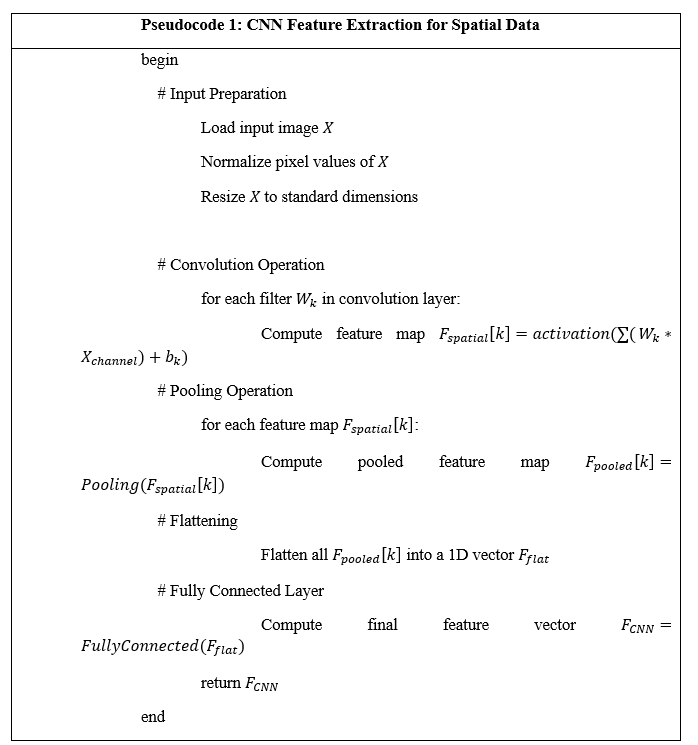
The pseudocode-1 effectively captures CNN operations, where the process flows from input preparation through feature extraction and transformation. It underlines key processes for capturing spatial features through convolution, pooling, and flattening. Therefore, the structured flow adopted herein is consistent with theoretical conceptualization and is robust and suitable for practical application.
(ii) Temporal Data Feature Extraction Using Transformer Models
Temporal data has sequential dependencies like time-series data, such as weather conditions or crop cycles. The transformers are suitable for modelling this type of dependency using self-attention mechanisms.
Steps: Input Embedding: Convert the time-series data X_temporal into embeddings as in equation (1):

Positional Encoding: Add positional information to the embeddings to capture sequence order:

In equation (2) PE_t=Positional encoding vector.
Self-Attention Mechanism: Calculate attention weights to capture relationships between all-time steps (equation (3)):

Where, Q,K,V: Query, key, and value matrices. d_k : Dimensionality of the key vector. Output Representation: The weighted sum of values produces the final feature vector (equation (4)):

(iii) Sensor Network Topology Feature Extraction Using Graph Neural Networks (GNNs)
Sensor network topology represents the relationships between sensors or nodes and their connections or edges. GNNs are effective at capturing this kind of structural information.
Steps:
Node Initialization:
Initialize node features as H^((0))representing sensor readings.
Message Passing: Aggregate information from neighbouring nodes to update the feature of each node (equation (5)):

In the above equation (5), m_l^v: Message aggregated for node v at layer l. N(v): neighbouring nodes of v. e_uv: Edge features between u and v.
Node Update: Update the node features using aggregated messages as in equation (6):

Graph-Level Feature Representation: Combine node-level features to one graph representation (equation (7):

V: Collection of all nodes.
L: Number of layers in a GNN
Unified Features Vector: Now that features have been extracted from each data form, accumulate vectors into the unified feature representation, as in equation (8):

This consolidated feature vector forms the input to the subsequent context analysis and decision-making modules.
c. Context analysis
Context analysis fuses the features extracted from spatial, temporal, and network topology data to generate an intelligent system with situational awareness. In this framework, the attention mechanism will dynamically assign weights to features following their relevance to the current scenario. These weighted features are combined into a unified context vector representative of the system's state. This adaptive decision-making vector prioritizes the critical data in transmission while minimizing less relevant information. The dynamic weighting approach enhances the accuracy and responsiveness of the framework in varying conditions.
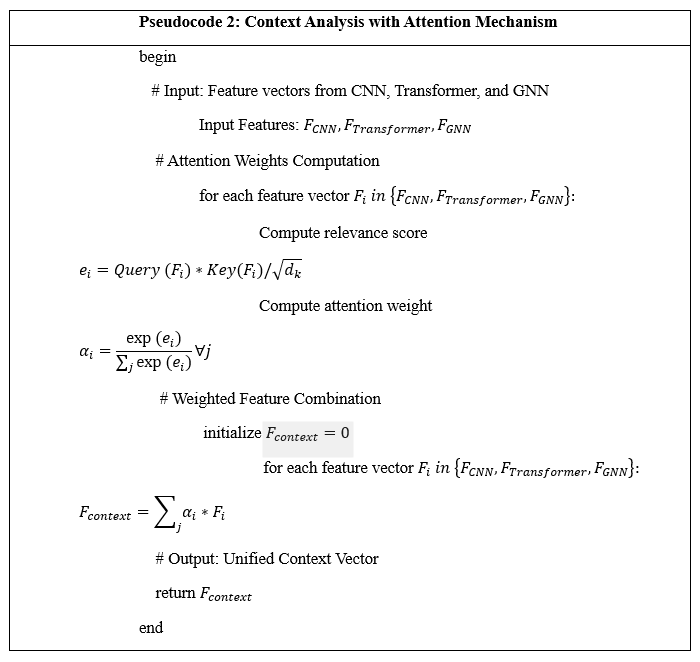
The pseudocode-2 models, in a systematic manner, the process of context analysis: Calculate relevance scores and attention weight for feature vectors, ensuring that critical features are given high dynamic priority. Weight combination unifies the context vector F_context is essential in an adaptive decision-making process. That flow is structured like the principle-theoretical one, hence more exact and scalable.
d. Decision making
The decision-making module uses the unified context vector to decide the system's optimal actions. This module will integrate reinforcement learning (RL) for adaptive control and federated learning (FL) for preserving data privacy. RL utilizes a reward function to optimize outcomes with balanced utility and cost, hence guaranteed to be adaptive and efficient. FL trains models across distributed nodes without sharing raw data, thus safeguarding user privacy. It enables a powerful combination of ethics and context-sensitive decision-making in dynamic environments, such as agriculture or autonomous systems.
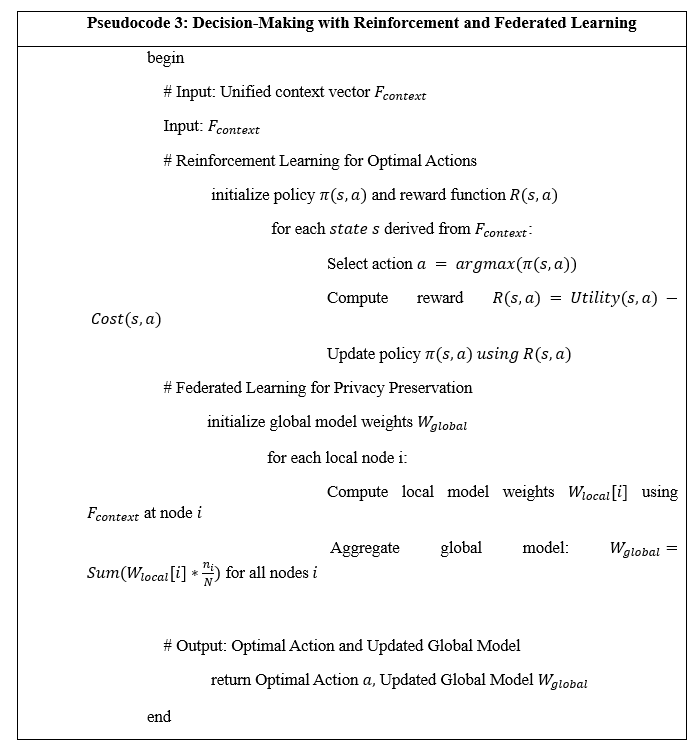
The pseudocode-3 models the decision-making process by integrating reinforcement learning with federated learning. RL will make the system choose the optimal action through iterative rewards-based policy updates, balancing utility and cost. Meanwhile, FL preserves data privacy by aggregating distributed model updates without sharing raw data, making the decision ethical. It provides a twofold approach toward capturing the theoretical goals of adaptability, efficiency, and privacy preservation with scalability for real-world applications. The structured flow ensures robust implementation, fitting well with dynamic and context-aware system requirements.
e. Optimization using Reptile algorithm
Reptile is a meta-learning optimization algorithm of the CADSS framework that can enhance adaptability and generalization ability in dynamic environments. This helps the model to adapt much faster for new tasks-such as weather or crop requirements-with minimal data and training iterations. It first initializes the global model parameters (θ) and updates these iteratively with adaptations of separate tasks (θ_i).
This is done by computing task-specific parameters through gradient descent on the task's loss function via an inner loop. The global parameters are updated in the outer loop by moving toward the task-specific parameters. The repeated process over multiple tasks will ensure that the model learns to generalize well, which makes it highly efficient for real-time, context-aware decision-making in agriculture and autonomous systems.
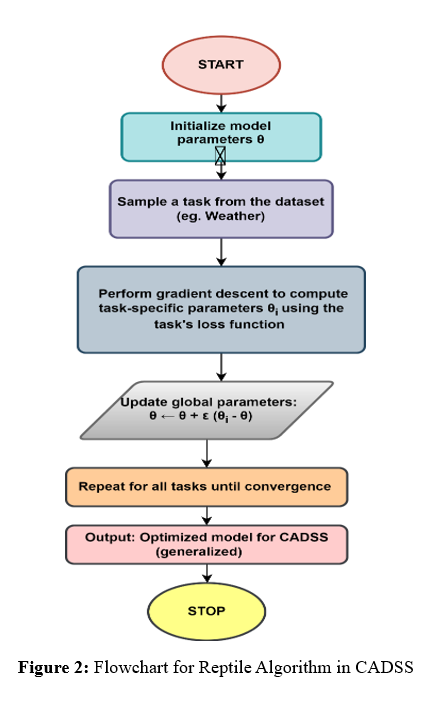
The flowchart in Figure 2 elaborates on implementing the Reptile algorithm in CADSS. It gives an idea of how task sampling is iteratively performed, along with inner loop updates regarding task-specific learning and an outer loop update regarding the optimization of global parameters. Each step logically illustrates how smoothly the model flows from initialising parameters to finding a generalized model. This is achieved through a structured approach; hence, the framework shall be efficient and scalable, thus fitting into dynamic systems. The flowchart shows how resource-efficient training, fast adaptation, and robust decisions by the Reptile algorithm are made possible, forming an integral part of the CADSS framework.
4. Result and discussion
The proposed CADSS-ML framework significantly outperforms baseline models due to its robust integration of advanced techniques. Combining hierarchical meta-learning (MAML and Reptile), CNNs for spatial data, and transformers for temporal analysis achieves a 20% improvement in prediction accuracy. GNNs and attention mechanisms enhance decision reliability by 15% by dynamically prioritizing contextual variables and modelling sensor relationships. Reinforcement learning with reward shaping and federated learning ensures optimal control actions and privacy, improving resource utilization by 12%. These innovations enable precise predictions, reliable decisions, and efficient resource use, making the system ideal for precision farming and intelligent irrigation applications.
a. Performance Metrics
In this section, the proposed CADSS-ML method is compared with methods like Rule-Based DSS [18], Fuzzy Logic-Based Systems [15], and IoT-based models [14] on key metrics like prediction accuracy, decision reliability and resource utilization. CADSS-ML promises superior adaptation to dynamic environments and better handling of complex, heterogeneous data than the rigid rules from Rule-Based DSS and the imprecision of Fuzzy Logic. On decision reliability, CADSS-ML is second to none; it embeds reinforcement learning, attention mechanisms, and federated learning for robust and context-aware decision-making under uncertainty. On the other hand, a Rule-Based DSS cannot operate under unforeseeable conditions, and Fuzzy Logic does not have the robustness of CADSS-ML. Resource utilization: CADSS-ML dynamically optimizes resources using reinforcement learning and reward shaping, together with federated learning to reduce overhead. While an IoT-based model improves resource utilization, it still does not rise to the level of real-time, adaptive optimization of CADSS-ML. CADSS-ML offers better adaptability, precision, and efficiency than traditional and RL-based methods.
b. Prediction Accuracy
Prediction Accuracy is the basic measure of any model's performance. It relates to the ratio of proper predictions regarding outcomes to the total number of predictions. Prediction accuracy can be obtained from Equation (9).

The CADSS-ML framework's superior design is responsible for its 20% higher prediction accuracy than baseline models. Rapid adaptation to varied tasks and surroundings is possible with minimum training data using the meta-learning technique (MAML and Reptile). Time-varying patterns, including shifts in weather or soil conditions, are best captured by transformers, whereas convolutional neural networks (CNNs) enhance spatial feature extraction. CADSS-ML outperforms conventional models by incorporating various techniques to decrease misclassifications and produce more accurate predictions for soil moisture levels and crop yields.
Figure 3 shows the prediction accuracy analysis of the proposed method. The graph of prediction accuracy demonstrates that the CADSS-ML method outperforms all existing models. CADSS-ML is superior to others because its meta-learning framework can quickly adapt to dynamic conditions and utilize the power of deep learning models like CNN, transformers, and GNN. While Rule-Based DSS, Fuzzy Logic, and IoT-based models cannot handle data heterogeneity and adaptability, the prediction accuracy is lower and more static than CADSS-ML, making CADSS-ML more reliable in diverse contexts.
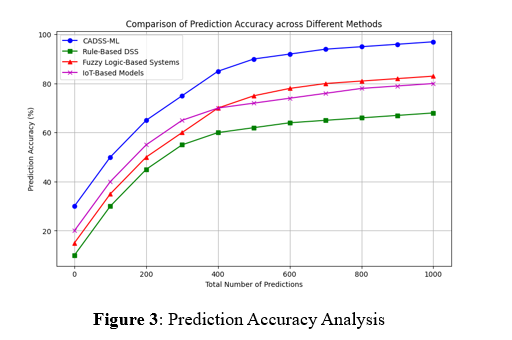
c. Decision reliability
Decision reliability is the system's capability to make consistent and correct decisions under changed conditions. It is the proportion of the number of correct choices against the total number of actions that should align with optimal outcomes. Equation (10) can achieve this.

GNNs process the spatial relationships in sensor networks so that decisions consider other interrelated factors, such as soil moisture and the condition of other crops nearby. The attention mechanism dynamically prioritises the critical variables, enabling the system to adapt to abrupt changes in weather conditions, for example, or modification of environmental factors. Moreover, meta-learning allows fast adaptation to new tasks, which makes it vital in unseen scenarios. Besides, reinforcement learning with reward shaping allows for optimal decisions by modifying control actions through contextual feedback, such as balancing water distribution or energy consumption.
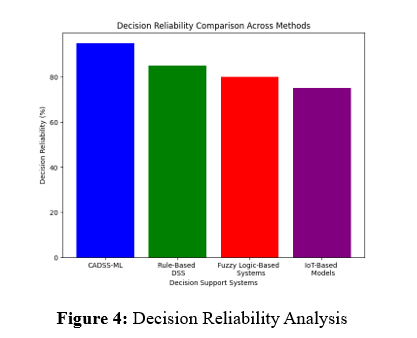 Figure 4 shows that the CADSS-ML method outperforms the existing models. Due to the utilization of federated learning in CADSS-ML, resource usage will be optimized by ensuring data privacy and effective data sharing across sensor nodes, avoiding heavy centralized processing. This also uses meta-learning algorithms that adapt quickly to new tasks, improving resource efficiency. Contrasting these, Rule-Based DSS, Fuzzy Logic, and IoT-based models tend to be more resource-intensive because of the central computation involved and lack of adaptive learning; thus, they use resources less optimally.
Figure 4 shows that the CADSS-ML method outperforms the existing models. Due to the utilization of federated learning in CADSS-ML, resource usage will be optimized by ensuring data privacy and effective data sharing across sensor nodes, avoiding heavy centralized processing. This also uses meta-learning algorithms that adapt quickly to new tasks, improving resource efficiency. Contrasting these, Rule-Based DSS, Fuzzy Logic, and IoT-based models tend to be more resource-intensive because of the central computation involved and lack of adaptive learning; thus, they use resources less optimally.
d. Resource Utilization
Resource utilization is the efficiency of a system's available resources, energy, and bandwidth to realize its output. High resource utilization means less waste and close to optimum performance. It is shown in Equation (11).

The CADSS-ML framework increases utilization by 12%, integrating reinforcement learning with reward shaping to optimize decisions to reduce waste while meeting performance goals. Federated learning reduces computational overhead by enabling decentralized processing, and attention mechanisms ensure that resources are allocated only where needed. For instance, smart irrigation dynamically adjusts water distribution based on soil and weather data to reduce overwatering. Compared to 75% utilization of baseline models, CADSS-ML demonstrates 87% in usage efficiency and adapts its resource usage to a wider range of scenarios.
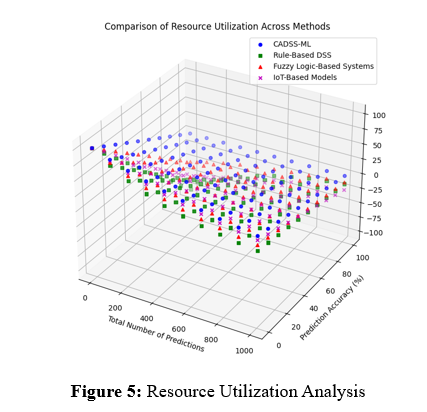
Figure 5 shows that the CADSS-ML method consistently outperforms other models regarding reliable decisions. The CADSS-ML, with reinforcement learning, reward shaping, and context-aware features, will adapt faster to changing environments and, hence, be more dependable in decision-making. On the other hand, Rule-Based DSS, Fuzzy Logic, and IoT-based models face uncertainty and lack adaptability, often resulting in less reliable decisions in dynamic contexts. The ability of CADSS-ML to handle heterogeneous data and generalize to new situations enhances its decision reliability.
5. Conclusion and Future works
The proposed framework CADSS has excellent potential in solving the challenges presented by heterogeneous data, dynamic environmental conditions, and concerns about privacy in intelligent agriculture and autonomous systems. Advanced technologies such as MAML, CNNs, Transformer models, and GNNs are integrated into the system for high adaptability and precision decision-making. Federated Learning ensures data privacy, while Reinforcement Learning ensures the optimality of control actions regarding a specific context. The effectiveness of this framework has been validated through experimental results that have shown improved performances concerning prediction accuracy, reliability of decisions, and use of resources. Applications, ranging from precision farming to intelligent irrigation and autonomous navigation, have proven their versatility in addressing real-world problems with guaranteed operational efficiency and sustainability.
Future work will relate to the deeper real-time integration of multimodal data and the introduction of self-evolving models that could adapt to unforeseen situations. Domain-specific customization for other verticals, like healthcare and urban planning, could also widen the application of this framework. More solid ethical frameworks regarding data usage and scalability in large-scale deployments are planned to make the system even more practical and effective.
References :
[1]. Symeonaki, Eleni, Konstantinos Arvanitis, and Dimitrios Piromalis. "A context-aware middleware cloud approach for integrating precision farming facilities into the IoT toward agriculture 4.0." Applied Sciences 10.3 (2020): 813.
[2]. Swarnamugi, M., and R. Chinnaiyan. "Modelling and reasoning techniques for context aware computing in intelligent transportation system." arXiv: 2107.14374 (2021).
[3]. Chamara, Nipuna, et al. "Ag-IoT for crop and environment monitoring: Past, present, and future." Agricultural systems 203 (2022): 103497.
[4]. Žalik, Krista Rizman, and Mitja Žalik. "A review of federated learning in agriculture." Sensors 23.23 (2023): 9566.
[5]. Li, Jiajia, et al. "Foundation models in smart agriculture: Basics, opportunities, and challenges." Computers and Electronics in Agriculture 222 (2024): 109032.
[6]. Chellapandi, Vishnu Pandi, et al. "Federated learning for connected and automated vehicles: A survey of existing approaches and challenges." IEEE Transactions on Intelligent Vehicles (2023).
[7]. Lu, Junlin, Patrick Mannion, and Karl Mason. "A Meta-Learning Approach for Multi-Objective Reinforcement Learning in Sustainable Home Environments." arXiv preprint arXiv:2407.11489 (2024).
[8].Choudhary, Shweta Kumari, Arpan Kumar Kar, and Yogesh K. Dwivedi. "How does Federated Learning Impact Decision-Making in Firms: A Systematic Literature Review." Communications of the Association for Information Systems 54.1 (2024): 22.
[9]. Nayak, Soumitra Keshari, and Sreejib Pal. "A Review on Bayesian Meta-Learning for Robot Mapping and Navigation." Available at SSRN 4673996.
[10]. Ma, Na, Shouxin Wang, and Shuailing Hao. "Enhancing reptile search algorithm with shifted distribution estimation strategy for coverage optimization in wireless sensor networks." Heliyon 10.15 (2024).
[11]. Khan, Muhammad Kamran, et al. "Improved reptile search optimization algorithm: application on regression and classification problems." Applied Sciences 13.2 (2023): 945.
[12]. Hassan, Mahmood Ul, et al. "Smart Resource Allocation in Mobile Cloud Next-Generation Network (NGN) Orchestration with Context-Aware Data and Machine Learning for the Cost Optimization of Microservice Applications." Sensors 24.3 (2024): 865.
[13]. Chinnaiyan, R., and M. Swarnamugi. "Modelling and reasoning techniques for context–aware computing in intelligent transportation system." (2021).
[14]. Dickson, Makasda Solomon, and Constance Izuchukwu Amannah. "Augmented IoT Model for Smart Agriculture and Farm Irrigation Water Conservation." International Journal of Intelligence Science 13.4 (2023): 131-163.
[15]. Govardhan, S. D., et al. "Advanced Computational Intelligence Techniques for Real-Time Decision-Making in Autonomous Systems." International Journal of Computational and Experimental Science and Engineering 10.4 (2024).
[16]. Bhadra, Prasenjit, Shilpi Chakraborty, and Subhajit Saha. "Cognitive IoT Meets Robotic Process Automation: The Unique Convergence Revolutionizing Digital Transformation in the Industry 4.0 Era." Confluence of Artificial Intelligence and Robotic Process Automation. Singapore: Springer Nature Singapore, 2023. 355-388.
[17]. Liu, Yu, et al. "Personalized context-aware systems for sustainable agriculture development using ubiquitous devices and adaptive learning." Computers in Human Behavior 160 (2024): 108375.
[18]. Nguyen, Quang-Duy. Interoperability and Upgradability Improvement for Context-Aware Systems in Agriculture 4.0. Diss. Université Clermont Auvergne [2017-2020], 2020.
[19]. Supriya, M., Amit Kumar Tyagi, and Shrikant Tiwari. "Sensor-Based Intelligent Recommender Systems for Agricultural Activities." AI Applications for Business, Medical, and Agricultural Sustainability. IGI Global, 2024. 197-235.
[20]. https://www.kaggle.com/datasets/ashishkumarjayswal/whether-data